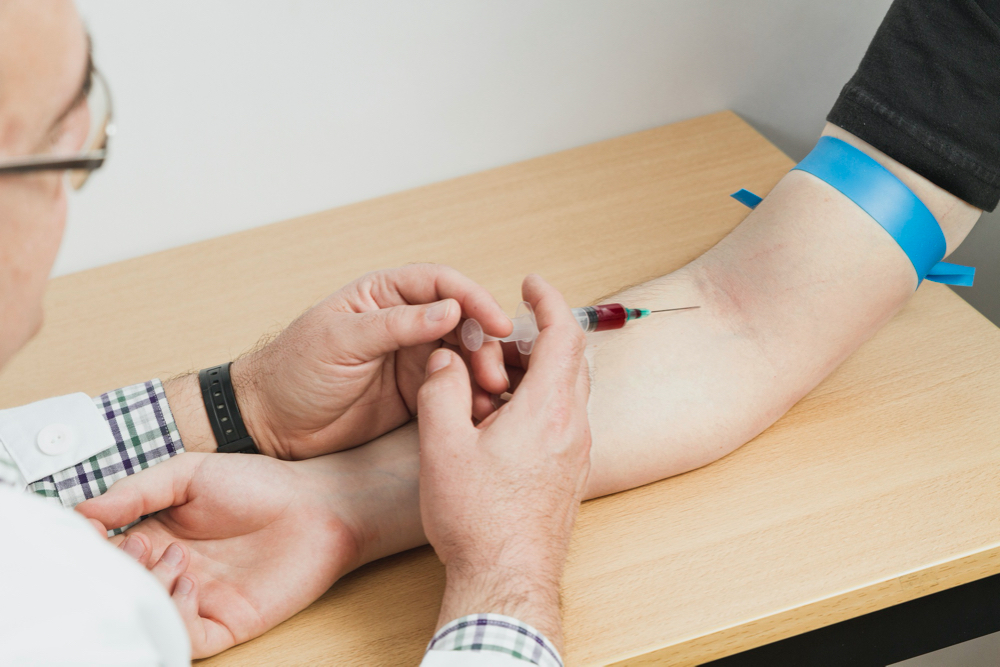- Fast results
- 4,000+ locations
- 4.8 star rating
Need Help? (888) GET LABS



If you have to get your blood drawn for a test and you’re afraid of needles, then you’re not alone. Anxiety surrounding needle insertion and blood affects many people, but it shouldn’t keep you from getting a life-saving blood test. To help you prepare for blood collection, here are tips to consider if you want to remain calm and predisposed for accurate testing.
The last thing you want when getting your blood drawn is to redo it because you missed the special prep before the procedure. Although your phlebotomist (medical professional who draws blood) will ask if you followed the preliminary steps for the test before collecting your blood, it will save you time and energy if you’ve come prepared.
Keep in mind that how well you’ve followed the required preparation determines test accuracy. When booking your blood test, check for specific preps such as:
You can also ask your doctor, especially if you’re taking prescribed drugs or undergoing treatment for a medical condition.
Even if the blood test requires fasting, you can still drink water. In fact, you are encouraged to stay hydrated before the test as dehydration can impact the accuracy of several blood tests, such as lipid panel and blood urea nitrogen (BUN) test. Plus, it’s easier for the medical technician draws blood from your vein as it’s more fluid when you’re hydrated.
Sleep does not affect your blood test results. However, not being able to get proper sleep the night before your lab appointment can aggravate the unpleasant experience. You may feel tenser than you already are. In addition, there’s a higher chance of the insertion site getting inflamed due to sleep loss.
While there’s no dress code for a blood test, it would be much easier for the phlebotomist to perform venipuncture (blood collection from a vein) when you’re wearing a short or sleeveless upperwear.
Venipuncture is commonly done in the forearm. Hence, freeing the insertion point allows for better access and accuracy when detecting the vein. On some rare occasions, the procedure is performed on foot, but this is a “last resort” kind of situation.
If you’re fasting within specific hours, it’s best to hit the laboratory early so you can have your blood drawn within the required timeframe. Also, arriving before the scheduled procedure helps you mentally prepare and keeps you away from feeling stressed over not coming on time.
Medical labs open as early as 7 or 8 am. Check the operating hours of the partner patient center you chose from our lab locator when you order a blood test.
With blood tests arranged and scheduled online, all you need to secure during the procedure, as far as setup goes, are the lab order and a valid ID card. The lab order serves as your doctor’s order for the blood test and comes after you book the test in your online account. As it’s readily available, all you have to do is print and bring it to the lab. Your appointment will show on the partner patient center’s schedule, and you will only need your ID for verification.
When getting a blood test, your goal as a patient is to cooperate for a swift, accurate, and less painful experience. To do this, you must answer any questions the medical technician raises and complete any form they require.
Dishonesty during these events can taint your test results. For example, if you have failed to fast or abstain from activities before your test, better inform the phlebotomist instead of covering it up. That way, you could get another schedule instead of booking and paying for another one.
A simple breathing exercise may help ease your anxiety if you’re anxious before the blood collection. Full deep breaths can calm your mind and encourage your body to relax.
Do this by inhaling slowly through your nose. Feel your abdomen expanding and your chest rising a bit. Then, slowly exhale through your mouth while slightly pursing your lips, creating a whooshing sound.
Whether it’s the blood or needle that gives you the heebie-jeebies, taking your eyes off the insertion may help you deal with the fear. Simply looking away from when your blood is drawn can reduce uneasiness, allowing you to direct your focus elsewhere. You can even close your eyes if you want.
Although no evidence supports its effectiveness in making venipuncture or injections less scary, phlebotomists still advise patients to look away during needle insertion since it makes them perform the procedure easier.
Thinking less about the blood, needles, pain, and hyperbolic events your imagination associates when getting blood drawn can alleviate the mental discomfort. To do this, bring items that can divert you from overthinking. For example, you can use your phone to play music or even watch a video, provided you arrange the setup with your clinician. Squeeze a stress ball or play with a fidget toy.
If you’re concerned about the physical discomfort of venipuncture, you can request for numbing cream or topical anesthetic with lidocaine. This will reduce the pain of the skin puncture. However, consult with the clinician first to avoid unwanted incidents such as allergic reactions or delayed effects.
A good way to lessen your fear of having your blood drawn is to trust the professional phlebotomist who performs the procedure. Understand that this individual has the expertise and experience of doing safe and adequate blood collection.
Communicate your anxiety and show your confidence to the person drawing your blood. In return, the phlebotomist will carry out possible ways to reduce your discomfort, such as speaking gently during the process and inserting the needle with extra care.

During your blood test, the phlebotomist follows a clinical protocol to collect your blood. Phlebotomists are trained medical professionals who ensure the procedure is safe and successful, allowing accurate parameter readings. For this reason, blood tests should be generally done in the laboratory instead of elsewhere and on your own.
Here are the steps for getting blood drawn out for a lab test.
The entire process could take 2 to 5 minutes, including the preliminary assessment. If you’re fasting, you can eat as soon as you complete the procedure.
You may feel a sting or pinch when the needle is inserted under the skin and into the vein to draw blood. For some people, the pain is tolerable, and they appear to be unbothered throughout the procedure. But others who experience discomfort at the sight of a needle may feel nervous.
While it is uncommon to have serious side effects after getting your blood drawn, you may feel dizzy, nauseated, or even faint after the blood test. These can be due to increased discomfort or high-stress levels during the procedure.
After the blood collection, stay still and avoid moving too much. Relax, be calm, and know that the hard part is over.
If you’re afraid of needles but need to have your blood drawn for a diagnostic or routine test, you can explore relaxation techniques before and during the procedure. For example, breathing exercises can relieve your anxiety about needles.
Also, it would help to reassure yourself that the slight pain only happens briefly and diminishes fast. Additionally, know that the blood test has a much bigger role in your health than a few seconds of discomfort.
Whether you’re above or below the pain tolerance of blood testing, having your blood drawn does not exactly spell fun and pleasant. Still, it’s necessary to assess your health, detect health abnormalities, and monitor your progress. By employing the tips above, you could lower your discomfort and soldier through the uneasy process.

© Copyright 2025 Personalabs. All Rights Reserved.